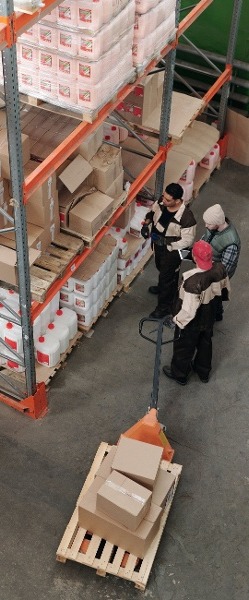Share this
Downtime in Manufacturing: 5 Electronics Supply Chain Causes
by Simcona on Jul 2, 2025 12:15:00 PM

Manufacturing: $260,000. Telecommunications: $2 million. The energy industry: $2.5 million.
Those industry averages aren’t CEO salaries or advertising budgets – they’re average costs of 1 hour of downtime, most of it unplanned.
If those numbers are new to you and downtime is a constant at your company, there’s room to turn things around.In electronics manufacturing, most troubleshooting guides for unplanned downtime focus on asset failure. That’s a huge cost factor in downtime, but don’t let your supply chain off the hook. It’s easy to blame the world (COVID, war) for sourcing problems, but many supply-related causes of downtime in manufacturing are preventable.
Let’s look at five sources – internally, on the distribution side, and on the component maker’s side – where costs may be piling up at your feet.
Vendor, Supplier, or You? What Causes Downtime in Electronics Manufacturing
Again, we’re focusing on causes of unplanned downtime costs that come directly from your company’s component supply chain issues:
- Poor management of demand
- Inventory mismanagement & messy warehousing
- Lack of design expertise
- Bad, counterfeit, and/or overseas parts
- Flaky vendor or supplier network
1. Poor Management of Demand
Whether for your internal operation or the product you’re manufacturing, the inventory, spare parts, and other resources for the job must be available. ASAP. Waiting for parts to arrive can halt production, leading to costly delays and missed deadlines.
More than ever, it’s difficult to source reactively rather than forecast your needs. Especially in the case of high-demand or specialized components, you're setting up your production line for interruptions.
Is your team equipped to handle spikes in demand? A key employee on an extended absence could cause the sourcing team itself to become the source of slowdown, especially in smaller operations. Even at full staffing, a team’s inability to scale output on short notice could put the whole operation on ice.
Solution:
There are two ways to improve sourcing consistency: by diversifying your supplier list and working through a distributor.
When an unforeseen problem occurs and your eggs are all in one supplier basket, production comes to a standstill. A supply chain with two or more suppliers means one vendor’s shortage is less likely to shut down your operation.
It’s also wise to give distributed sourcing a try. A distributor is more equipped to handle electronic component shortages than a single company. It has a dedicated staff with the bandwidth to:
- Watch market trends
- Perform bulk orders at discount prices
- Make last-time buys
2. Inventory Mismanagement & Messy Warehousing
Without a well-organized system for tracking and replenishing stock, you risk running out of essential components, which can bring your production line to a standstill.
Inefficient warehousing can exacerbate this issue. Poor arrangement, labeling, and tracking can lead to various shades of bad for your production schedule:
- Bad: Retrieving parts becomes a time-consuming process
- Worse: An order is lost, and you must wait for a reorder to arrive
- Worst: The wrong part type is pulled out for use, resulting in rework or recalls
Solution:
Luckily, this might be the most fixable cost of downtime in manufacturing. A little improvement in material handling can reduce machine downtime dramatically!
- Software – Modern inventory management software gives you real-time information on existing stock levels, how long it’s been there, and past incoming and outgoing orders. Many platforms also track component sales trends and obsolescence notices, helping you avoid shortages and better forecast needs.
- Warehouse layout – Better facility logistics speed up picking and make tracking inventory levels easier. Order volumes will be more accurate, and you won’t end up with too much or too little.
- Third-party distributor – Just like with sourcing, a dedicated distributor has more bandwidth to do the job right. Some vendors offer sourcing, warehousing, inventory management, and component kitting services in one package. Either way, a third party will have the software and space to take the headache off your hands.
3. Lack of Design Expertise
You don’t know what you don’t know.
Sometimes, unnecessary downtime occurs simply due to a lack of expertise in component function, quality, and material makeup. Waiting for a specific part to arrive for 11 weeks is a waste when a similar, more readily available replacement could be there in 11 days.
If your part is obscure or in high demand, you might be shooting yourself in the foot by being adamant about its inclusion.
Solution:
First off: Stick to common parts and materials when at all possible. If you follow the other tips we’re sharing, you’ll be more prepared to snag popular parts before they run dry.
If you value design consulting at the assembly and production levels, you may also benefit from an outside expert at the component level. Some electronics distributors double as turnkey manufacturers, meaning they understand the components they’re selling to you – they’ve probably used them themselves.
Get a pair of expert eyes on your product to see if a substitute part can serve the same function without compromising quality. A real whiz might even be able to design the component out of your assembly entirely.
4. Bad, Counterfeit, and/or Overseas Parts
Everyone and their brother can set up a website and sell components online these days. And there are “vendors” in Asia who literally make their living by scraping components off electronics that were dumped in landfills.
Overly relying on a “cheapest possible” strategy, or buying from the gray market, is asking for trouble. Introducing bad parts into your system is less “shortcut” and more “short-sighted” (or “short-circuit”).
A bad part could delay launch due to poor results in production. An even-worse part could end with you mass-recalling launched products because they’re endangering the public.
The costs associated with recalls and rework go beyond just the financial aspect; they also include the time and resources spent on identifying and rectifying the issue.
Even if you use a reliable offshore vendor, you’ll still deal with longer freight waits (with more potential for shipping damage and saltwater corrosion). Communication barriers and weather events can tack on further delays.
Solution:
Stick to reputable manufacturers who ensure nothing bad enters your assembly. Paying a few more bucks up-front is better than halting production later.
Your distributor can’t really identify bad parts during fulfillment, but it can at least source from manufacturers known for high-quality stuff that avoids banned materials. And an onshore component distributor will deliver your parts more quickly and smoothly.
5. Flaky Vendor or Supplier Network
... Speaking of which!
Even after COVID, there are still some supply chains that rely on a single source for products and parts. This keeps costs down when all is going well, but in times of supply turmoil it exacerbates the condition.
Even if you rely on a distributor, one with a limited supplier network can be a significant bottleneck in your manufacturing process. If the distributor can't meet your component needs due to a lack of variety or stock, your operation will have to scramble for support elsewhere.
There are plenty of bright-red flags to watch for when determining the reliability of a distributor or supplier:
- Inconsistent delivery timelines
- In business for a few years or less
- Financially unstable
- Shoves you aside when a larger client needs attention
Solution:
Choosing a distributor with a broad and respected supplier network (in the 100s) is vital for maintaining consistent production in any decent-sized business. It’s one of the first questions you should ask an electronics distributor when considering a partnership.
Such a company will add value to your operation by leveraging its powerful network and offering responsive customer service.
FAQs About Downtime in ManufacturingHere are some component-specific questions you might have about the causes of downtime in manufacturing. Q1: How can I calculate the actual cost of downtime specific to my facility?A: Start by estimating your average revenue per hour and multiply it by the length of the downtime. Add direct costs like labor, scrap, and expedited shipping, along with indirect impacts such as missed deadlines or customer dissatisfaction. While industry averages are a helpful reference point, your internal data provides a clearer picture. Many companies use ERP tools or downtime calculators, but the accuracy depends on tracking real numbers across departments regularly. Q2: What are early warning signs that an electronics supplier might become unreliable?A: Watch for missed delivery dates, poor communication, inconsistent product quality, or frequent contact changes. These can point to deeper issues like financial trouble or staffing shortages. A formal vendor review process – like scorecards, audits, or SLA tracking – can help you catch these issues early and reduce risk to your production schedule. Q3: What does a healthy, diversified supplier or distributor relationship look like in practice?A: It means having more than one trusted source for critical parts and a distributor who actively supports forecasting, inventory management, and quick sourcing. Strong partnerships are built on regular communication and shared expectations, just like any relationship. The goal isn’t simply pure speed; it's also reliability and the ability to adapt when something goes wrong. |
How to Reduce the Causes of Downtime in Manufacturing
Downtime is both a symptom and a cause.
It’s a symptom of poor inventory management, outsourcing, and partnerships. And it’s a disease in itself because it wastes employee hours, damages your brand, and strains your team.
Can you afford to lose $260,000? $2.6 million? If not, take stock of your current inventory, distribution, and supplier set. Consider whether a change in process (perhaps through outsourcing) is a better way of doing business. By realigning the supply chain at all links, you can maintain a healthier, more sustainable production rate.
Ready to Take Control of Your Supply Chain?
Download our free guide to start sourcing smarter and reduce downtime in your operational process.
Editor's Note: This article was originally published in October 2023 and was recently updated to reflect current industry trends.
Share this
- Components (38)
- Cost (29)
- Distribution (21)
- Materials (21)
- Cables & Wires (19)
- Supply Chain (19)
- Standards & Certifications (18)
- UL (17)
- Control Panels (16)
- Safety (14)
- Design (13)
- Contract Manufacturing (11)
- Inventory Management (11)
- News (10)
- Jacketing & Insulation (9)
- Suppliers (8)
- Wiring (8)
- Availability (7)
- Design & Engineering (7)
- Obsolescence Management (7)
- Testing & Prototyping (7)
- Maintenance & Downtime (6)
- Temperature & Fire Resistance (6)
- Enclosures (5)
- Manufacturing (5)
- Circuit Protection (4)
- Data Centers (4)
- Kitting & Fulfillment (4)
- Labeling (4)
- Sensors (4)
- Corrosion (3)
- Cooling & Fans (2)
- Datacom (2)
- Supplier Spotlight (2)
- Automation (1)
- Honeywell (1)
- PLCs (1)
- Relays (1)
- Security (1)
- October 2025 (1)
- August 2025 (1)
- July 2025 (6)
- June 2025 (4)
- May 2025 (4)
- April 2025 (3)
- March 2025 (11)
- February 2025 (3)
- January 2025 (2)
- December 2024 (1)
- November 2024 (1)
- October 2024 (1)
- September 2024 (3)
- August 2024 (1)
- July 2024 (4)
- June 2024 (3)
- April 2024 (2)
- March 2024 (1)
- January 2024 (1)
- October 2023 (1)
- June 2023 (1)
- May 2023 (1)
- April 2023 (1)
- March 2023 (2)
- October 2022 (1)
- March 2021 (3)





No Comments Yet
Let us know what you think